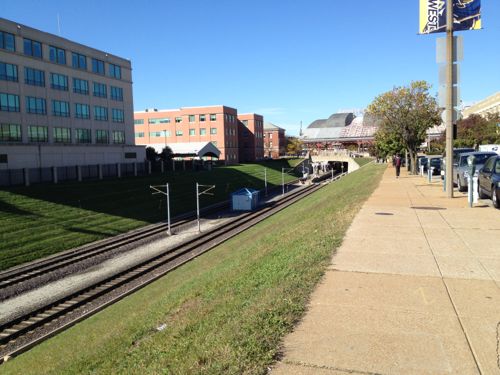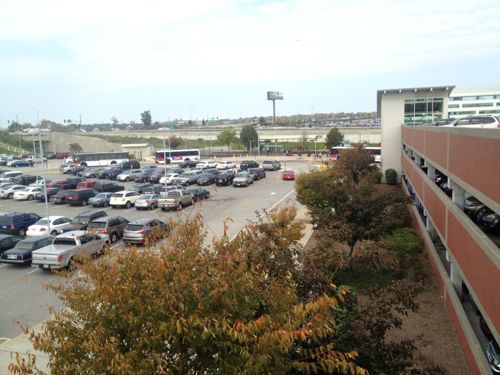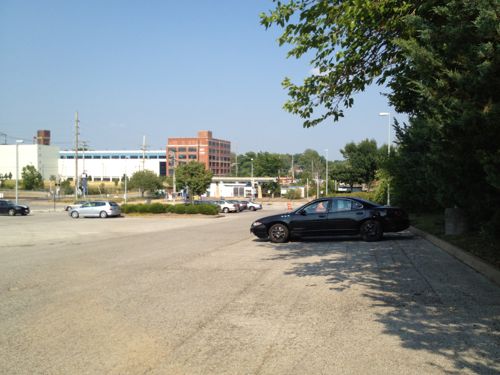Poll: Why So Little Transit-Oriented Development In The Last 20 Years?
The 20th anniversary of the opening of our light rail sys system, MetroLink, is next week.For the last 12-18 months there has been a big push by Citizens for Modern Transit and East West Gateway Council of Governments to kickstart development around the stations.



The poll this week lists many possible reasons why development hasn’t happened around the stations, you can pick up to 3. The choices are presented in random order.
On July 31st, MetroLink’s 20th anniversary, I’ll share my thoughts on why development hasn’t happened and what we need to do so the next 20 years are more productive.
— Steve Patterson
Actually there has been $15 billion in development within a 1/2 mile of MetroLink Stations. Unfortunately much of it is like Express Scripts at UMSL North where it is within walking distance, but not oriented to the station. The CWE ML station is perhaps the best example of redevelopment with higher densities around the station although one of the new developments is a parking garage close to the station. On the positive side the employers — BJC and WU– encourage transit use with transit pass subsidy programs. But there is also the Forest Park Hotel, Park East Tower and the lofts that have all come on line since the opening of ML. The McCormick Barron residential development at the Emerson Park ML station is the first new residential building in East St. Louis in many years. Again it is within walking distance of the station, but lacks mixed use and an orientation to the station itself.The redevelopment of downtown is all within walking distance of MetroLink stops. What part does MetroLink play in this redevelopment has not been studied. Most would credit historic tax credits. My take it is a variety of factors including transit, historic tax credits, daring developers, achieving a critical mass and a different life style choice by young people.TOD is taking off in high growth urban areas — Dallas, Portland, Seattle and elsewhere. Without the high demand, StL is muddling along. Some developers are beginning to understand the opportunity. Perhaps Cortex will be the “Show Me” TOD.
The BJC hospital complex would’ve grown anyway, the others barely qualify as “transit-adjacent.”
And look at the Grand station; there has been no development near that station (in that I mean the valley it is situated in). Same with Maplewood’s….Enterprise was there before, the businesses along Manchester were there before, etc. What development has taken place has been just new tenants, not new buildings. We give Metro too much of a pass when it comes to driving development.
I don’t disagree. Developers and tenants have a “belt and suspenders” mentality. Take the Meridian as an example; the developer wanted to be adjacent to MetroLink, the prime tenant (BJC) wants to be next to MetroLink yet they build a suburban style development. I know people who work there and take ML to work. Get off a train in the morning and it is filled with students going to the college in the development. Yet the whole thing sucks for pedestrians getting off the train.
One, there is no one, single, successful, high-profile project, here, that “less-enlightened” developers can look at and say, “Hey, I can make money at this!” In Denver, a dying mall (think Northwest Plaza or Crestwood Court) was redeveloped as the Englewood Town Center, and others followed. Two, there seems to be a significant negative perception, here, toward buses and their riders. Since bus connections happen at every Metrolink station, getting people to embrace both buses and rail will be critical to the success of any TOD here. And three, development is going to happen where the private sector is willing to invest, to spend their money, for whatever reasons those may be, however flawed they may be. Government can lead, government can cajole, government can incentivize, but government can’t force development to happen. Any “planning” for TOD needs to include the private sector, not just academics, bureaucrats and small-time politicians coming up with grandiose wishlists.
Talk about a negative perception of buses. This draft development plan for a Delmar Loop TOD wants to “hide the buses”.
http://skinkerdebaliviere.files.wordpress.com/2013/03/sdb_urbandesignplan_pubilcmeeting03_final_email_part1.pdf
“Preference: Redevelopment District
Option 1: 0; Option 2: 4
‘Hide the buses’
‘Use the Wabash Station’
‘Do not open Des Peres’
Unsure about the Transit Plaza”
Possibly dumb question, but are there examples of successful TOD in neighborhoods that didn’t already have high population densities before the arrival of mass transit?
Look at DC–Numerous examples there.
Yes, Denver, as in DC . . . , the real key is that people in both cities don’t view public transit as something just poor people (need to) use. In both cities, middle class workers and large numbers of college students use transit, buses included, to commute to work and classes every day.
Numerous reasons:
– No “overflow” demand from downtown (it’s still cheap enough to just live there)
– main line placed on cheap land with stops in undesirable locations: rail yards, bad neighborhoods–mostly in north county, etc
– racist crime fears: apartments next to transit means “transients too poor to afford cars moving in” or, alternatively, “who would want to live next to this pipeline to the ghetto?”
– culture in STL is *overwhelming* car-centric
– nobody with both the money and the vision. It’s like they say: “the people with taste have no money and the people with money have no taste”
The lack of TOD development goes back to city planning issues. The surroundings and the available land is not designated to support transit. Thus you have at the Grand Ave light rail station the suburban visions of SLU, which have nothing to do with transit, but everything to do with supporting auto’s.
I could go on, but the failure is in the government support for creating surrounding communities that support transit.
Capitalism has it’s own failures and is not the magic answer to anything unless guaranteed profits in the form of government guarantees to be included in any deal (see Paul McKee, Northside)
But ultimately it comes down to the fact the people running things don’t have a clue how to build cities properly, they have no idea how to create a mix of zoning, incentives, population density, using transit to create population nodes, public space and so on.
The Grand rail station is a prime example. The bottom line incompetence rules, and not surprisingly it is the oil/concrete cartel that wins out every time.
Until that stranglehold is broken, I don’t see any improvement on the horizon, even in the face of global warming and other issues that should be motivation for change.
America has a brain dead political system run for the benefit of the few, insuring decision making that can never make sense except in a world of insider profit taking. St. Louis is at the butt end of this sort of politics and likely Nome, Alaska will become more progressive in city planning and TOD before the entrenched power structure of St. Louis gets off its ass, or is completely overthrown, which in my view is preferable at this point.
I’ve mentioned before on this blog the multiple examples of TOD near the Forsythe and Galleria MetroLink stations. Others here have mentioned other examples. It is no surprise that stations like Wellston have no TOD, MetroLink makes the area slightly more desirable but it’s still a giant dump. The bottom line is that there has been TOD in some places – the ones you would expect it most – and not others. As for why there has been less TOD overall than in places like Denver or Charlotte – I agree with Thomas R Shrout that this is attributable to different growth rates. Here any TOD is in competition with a glut of existing real estate, while in those cities, new development has to occur and it is less of an adjustment to make it TOD.
The Richmond Heights station (Galleria) has zero TOD. The Boulevard is transit-adjacent, at best. The station location right next to a highway is part of the problem, a massive parking garage is between the station and the shops/residences, it’s the first thing you see when you come out from under the highway overpass. I can’t think of anything at Forsyth either.
The Boulevard is 100 meters away from the station, and has ground-level retail with 3 residential stories above. If that’s not TOD then what is?
As for Forsyth, compare the new condos here with the house which preceded Metrolink (and didn’t sell out to developers, unlike the others on its block).
http://goo.gl/maps/s6ZiX
TOD is leave the station, go next door or cross street and get lunch or buy a magazine. BTW, Google Maps shows the distance from the station to the north end of the Boulevard as 0.1 miles, which is 568 feet or 173+ meters.
The cities noted by Tom Shrout for having created TOD in their urban areas are Dallas, Portland and Seattle. How did they succeed in switching lifestyle choices from “auto-centric” to “pedestrian”? By providing more than one mode of higher-quality (rail) transit! Streetcars connect with light rail in each of those towns, and until we have something akin to that in St Louis, we’ll never coax enough people out of their cars to warrant all-new TOD. What we’ve got so far, as Steve Patterson said, is only TAD (Transit Adjacent Development). As for Tom’s hope that Coretex will usher in a new type of growth – won’t happen if they just insist Metro build them a light rail stop. The best hope is that Downtown Partnership coordinates with Coretex on what we can AFFORD, which is an electric trolley bus rapid transit on the projected service to CWE. Those quiet, clean and quick ETBs could run frequently on a circle route that reaches BJC and Coretex (out on Lindell, back on F.Pk.Pkwy.). Then, walkable developments would be a credible alternative to being tied to their auto. As per G. Michaud’s comment, perhaps City power brokers need to see such walkable developments linked to keeping the precious employee payroll taxes coming in!
Transit and TOD in all three cities, as well as in every legacy city (NYC, Chicago, San Francisco, Toronto, etc.) relies on a robust bus system as well as rail-based transit. The huge issue here is that bus transit is perceived by many to be a lesser form of transportation when it is, in fact, comparable to rail and serves a very real need. If we focus our TOD efforts solely on rail options, we’re not going to serve much of the region!